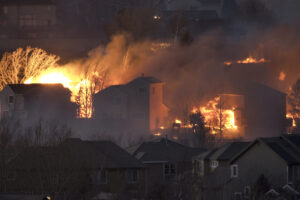
Natural disasters cost Allstate $864M in two-month span, triggering rate hikes
By onInsurance
Allstate reported $551 million in catastrophe losses in August alone, prompting the insurer to implement 7% rate increases throughout five locations.
When announcing its catastrophe losses, which totaled $864 million pre-tax for July and August combined, Allstate said the Maui wildfires accounted for about half of last month’s losses.
Favorable reserve reestimates for prior estimates helped offset the payouts, said Allstate, which has reported catastrophe losses and subsequent rate increases during every month of the year.
“Allstate continued to implement significant auto and homeowners insurance rate actions as part of our comprehensive plan to improve profitability,” said Jess Merten, Allstate’s chief financial officer. “Since the beginning of the year, rate increases for Allstate brand auto insurance have resulted in a premium impact of 8.6%, which are expected to raise annualized written premiums by approximately $2.23 billion.
“Implemented rate increases and inflation in insured home replacement costs resulted in a 13.2% increase in homeowners insurance average gross written premium in August 2023 compared to the prior year.”
According to a recently released Swiss Re report, U.S. underwriting losses reached $22 billion during the first half of the year, resulting in net income of $2 billion despite higher investment earnings.
“The P&C industry has not yet reached the inflection point between premium growth rates and claims costs,” Swiss Re said. “Instead, strong and accelerating rate increases in personal lines, an ongoing hard market in commercial property, and high reinvestment yields were offset by the costliest second quarter for natural catastrophes since 2011, persistent inflation, and slowing favorable reserve development.”
The market conditions prompted Swiss Re to raise its premium growth estimate from 7.5% to 9% this year. It is forecasting an additional 5.5% increase next year.
However, it added that within the auto insurance sector, “the worst appears to be over.”
“The line’s 112% combined ratio in 2022 was the highest since at least 1975 and the loss ratio is still elevated in 2023, suggesting a way to go before it turns a profit again,” its report said. “However, in Q2 2023, growth in direct premiums earned kept pace with loss costs for the first time in more than two years.
“We expect this trend to continue, with rate increases expected to exceed most indicators of claims severities.”
It noted that July’s Consumer Price Index (CPI) indicated car insurance prices were up 19% year-over-year as used car prices dropped 6.6%. During the same period, however, body work increased 7.1% and repairs went up 17%.
“Based on CPI data, statutory rate filings, and earnings call commentary, we expect earned premiums growth rates to continue to accelerate while loss costs decelerate,” Swiss Re said. “A potential stumbling block is the United Auto Workers strike that began on 15 September, which will disrupt supply chains and cut new vehicle production, and could cause an uptick in used car values.”
It added that personal auto and homeowners premiums both grew during the first six months of the year, leading to P&C growth of 8.6%.
“Personal lines look to be the growth engine of 2023,” it said. “We revise up our estimate of total direct premiums written growth to 9.0% in 2023 and maintain it at 5.5% for 2024, driven by rate gains in personal lines and commercial property.”
An earlier Swiss Re report indicated that profitability for non-life insurance companies was likely to improve globally as the industry adapts to elevated risk. It found that although a hard market is likely to continue, 2023 is expected to be a “transition year” globally for P&C insurance.
“Our analysis shows that non-life insurers’ profitability is set to improve strongly in the coming years as higher interest rates and rate hardening more than offset higher claims costs from persistent inflation,” said Jérôme Jean Haegeli, Swiss Re’s chief economist. “This will be vital to enable industry resources to grow at a rate that will match global demand for insurance protection.”
Images
Main image: File photo of a forest fire. (milehightraveler/iStock)
